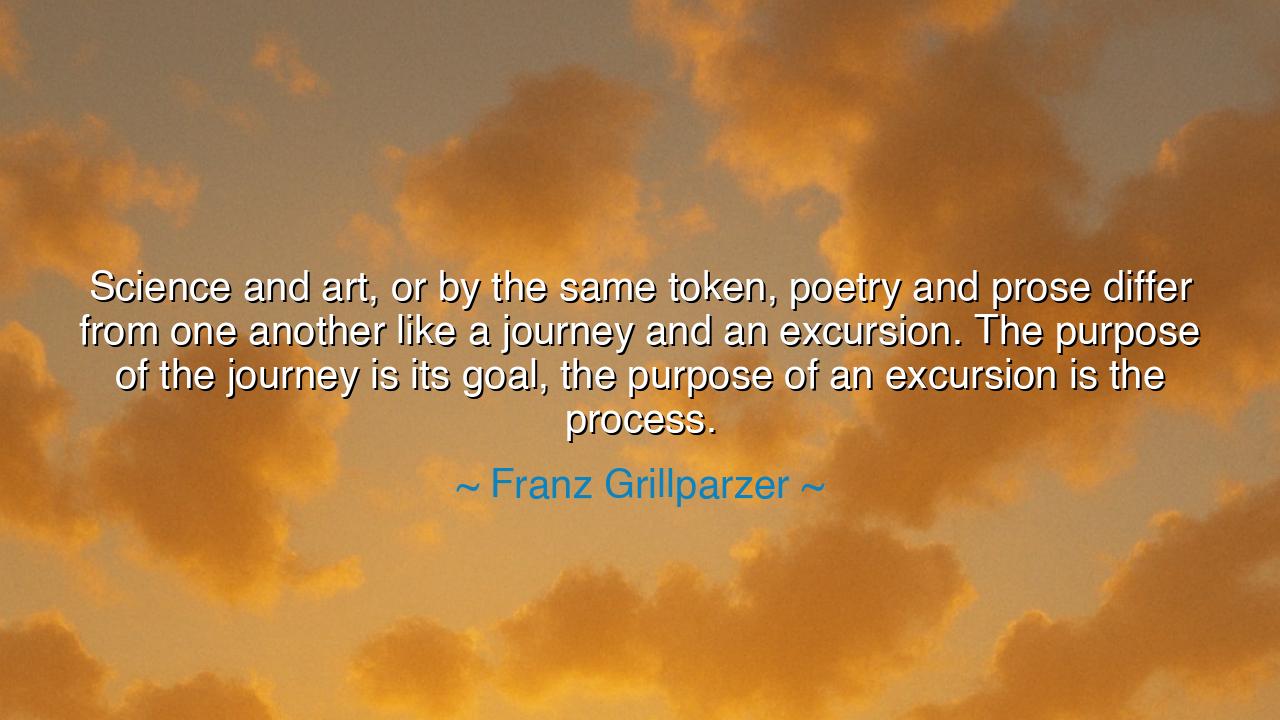
Science and art, or by the same token, poetry and prose differ
Science and art, or by the same token, poetry and prose differ from one another like a journey and an excursion. The purpose of the journey is its goal, the purpose of an excursion is the process.






"Science and art, or by the same token, poetry and prose differ from one another like a journey and an excursion. The purpose of the journey is its goal, the purpose of an excursion is the process." These words by Franz Grillparzer offer a profound reflection on the nature of science and art, each representing a different mode of understanding and engagement with the world. Grillparzer uses the metaphor of a journey and an excursion to differentiate between the goal-oriented nature of science and the process-focused nature of art. The journey, he suggests, is the pursuit of a destination, where the end point is paramount, while the excursion is about the enjoyment and the experience of the process itself, with no singular goal beyond the act of exploration.
In the ancient world, the great minds often spoke of the duality between reason and creativity, between the analytical pursuit of truth and the expressive quest for beauty. Plato distinguished between the rational pursuit of knowledge, which seeks to uncover immutable truths about the world, and the artistic expression that seeks to capture the fleeting, subjective nature of human experience. For Plato, the philosopher’s path was akin to the journey, seeking the truth that would lead to enlightenment, while the artist’s path was like an excursion, wandering through the world of imagination to evoke emotion and insight. Both, however, were essential in their own right, as each represented different facets of human understanding. Grillparzer's words resonate with this ancient understanding: science seeks the truth as its destination, while art seeks the experience of discovery itself.
The journey that Grillparzer speaks of—embodied in science—is a path driven by inquiry and discovery. Consider the work of Isaac Newton, whose pursuit of understanding the laws of motion and gravity was not a leisurely exploration, but a determined journey toward an undeniable conclusion: that the universe follows a set of predictable, scientific laws. For Newton, the goal of his journey was to uncover the fundamental truths of nature, to reach the summit of understanding. Each discovery he made along the way was part of the progression toward this final revelation. The journey, in this sense, is not about the experience, but about reaching the goal—the truth that was waiting at the end. This drive for knowledge is what has fueled the great discoveries of human history, from the theory of relativity to the exploration of the cosmos.
On the other hand, the excursion described by Grillparzer—embodied in art, poetry, and prose—is a different sort of engagement with the world. Here, the purpose is not to reach a final destination but to wander through the terrain of the human experience, to savor the beauty of the journey itself. Poetry, like the excursion, does not seek to prove or explain; it seeks to explore and to evoke. Consider the work of the ancient poet Homer, whose Iliad and Odyssey are not simple tales of war or adventure but are profound explorations of humanity, of the emotional landscape that drives men and gods alike. Homer did not seek to teach scientific truths but to immerse the reader in the complex emotions of love, rage, honor, and betrayal. The excursion of art and poetry is about the process—the exploration of human nature, the unfolding of experience without the need for a defined endpoint.
The relationship between science and art has always been a delicate one, each illuminating different aspects of human existence. The scientist, like the traveler on a journey, is bound by the laws of logic and evidence, searching for definitive answers. The artist, however, is like the wanderer on an excursion, driven by the desire to explore the uncharted realms of imagination and emotion, and often finding meaning in the journey itself. The truth of science is found in objectivity and proof, while the truth of art is found in subjectivity and expression. Both pursuits, though seemingly different, are essential to the human condition, and both are driven by a desire to understand the world—not just as it is, but as it feels and could be.
In our own time, Grillparzer’s distinction serves as a reminder of the importance of both reason and creativity in our lives. We must understand that science provides us with the answers to the questions we ask about the world, but art offers us a deeper exploration of the human spirit. Each has its place, and each contributes to a fuller, richer understanding of existence. In the quest for knowledge, we must be mindful of not only the destination but the journey itself. Just as Newton sought the final answers to the laws of the universe, we must also allow ourselves the freedom to wander, to explore, and to create, like the poet or the artist, for it is in the process of discovery that the truest revelations can be found.
The lesson we must take from Grillparzer’s words is one of balance. We must not solely focus on the goal of our endeavors, whether they are intellectual or creative. The pursuit of knowledge and truth is essential, but so is the enjoyment of the process. Let us, like the philosopher and the poet, embrace both the journey and the excursion, recognizing that the answers we seek and the experiences we enjoy are both integral to our understanding of the world. Whether in science or in art, it is the process of discovery—the unfolding of the world around us—that offers the richest experiences and the deepest wisdom. Let us therefore approach life with a mind open to both the pursuit of answers and the celebration of the journey itself.






AAdministratorAdministrator
Welcome, honored guests. Please leave a comment, we will respond soon